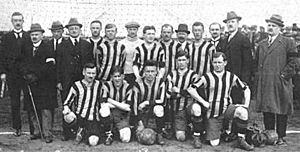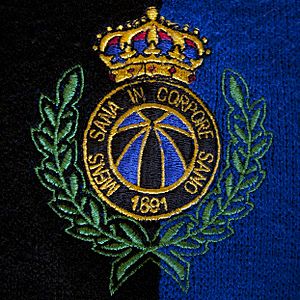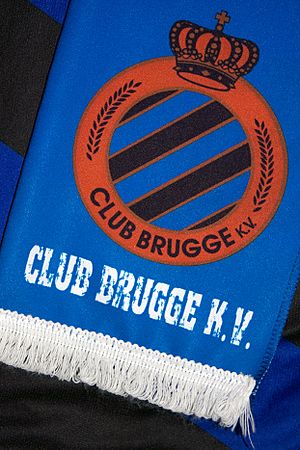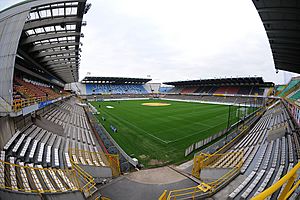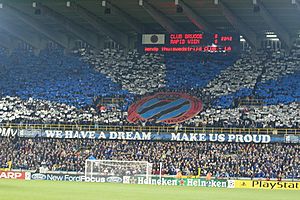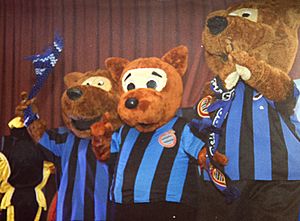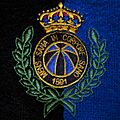Club Brugge KV facts for kids
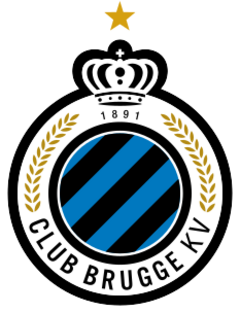 |
|||
| Full name | Club Brugge Koninklijke Voetbalvereniging (Club Bruges Royal Football association) | ||
|---|---|---|---|
| Nickname(s) | Blauw-Zwart (Blue-Black), (the) Club, FCB, FC Bruges | ||
| Founded | 13 November 1891 (as Brugsche FC) Stamnummer (matricule number) 3 |
||
| Ground | Jan Breydel Stadium | ||
| Capacity | 29,062 | ||
| President | Bart Verhaeghe | ||
| Head coach | Nicky Hayen | ||
| League | Belgian Pro League | ||
| 2024–25 | Belgian Pro League, 2nd of 16 (regular season) Champions Play-offs, 2nd of 10 |
||
|
|
|||
Club Brugge is a professional football club from Bruges, Belgium. It was started in 1891 and plays its home games at the Jan Breydel Stadium. This stadium can hold over 29,000 fans. Club Brugge plays in the Belgian Pro League, which is the top football league in Belgium.
Club Brugge is one of the most successful teams in Belgian football. They have won the Belgian league championship 19 times. Only their big rivals, Anderlecht, have won more. Club Brugge shares its home stadium with another local team, Cercle Brugge. Their games against each other are known as the Bruges derby.
The club has also done well in European competitions. They reached two European finals and three semi-finals. Club Brugge is the only Belgian team to have played in the final of the European Cup (now called the UEFA Champions League). They lost to Liverpool in the 1978 final. They also lost to Liverpool in the 1976 UEFA Cup Final. Club Brugge holds records for the most consecutive appearances in the UEFA Europa League (20), the most Belgian Cup wins (12), and the most Belgian Super Cup wins (18).
Contents
Club Brugge: A Journey Through Time
In 1890, students from two different schools in Bruges came together to form the Brugsche Football Club. They chose a Latin motto: 'mens sana in corpore sano', which means 'a healthy mind in a healthy body'. On November 13, 1891, the club was officially re-established as Brugsche FC. This date is now celebrated as the club's founding day.
In 1895, a national sports union was created, and Brugsche FC was one of its first members. They played in the very first Belgian football league season in 1895–96. After some money problems, a new club called Football Club Brugeois was formed by some members. But in 1897, the two clubs reunited under the name Football Club Brugeois. They didn't change their name to the Dutch "Club Brugge" until 1972.
In 1914, FC Brugeois reached their first Belgian Cup final but lost. Six years later, in the 1919–20 season, they won their first ever trophy: the Belgian First Division. To celebrate, they added "Royal" to their name, becoming Royal FC Brugeois. This "Royal" status is still part of their name today (KV stands for Koninklijke Vereniging, meaning royal club).
The club faced tough times in the 1940s and 1950s, spending many years in the second division. However, after the 1958–59 season, they were promoted back to the First Division and have stayed there ever since! In 1968, they won their first Belgian Cup, beating Beerschot A.C. in a penalty shootout.
Golden Years and European Adventures
Club Brugge had a very successful period under Austrian manager Ernst Happel. He led the team to win three league championships in a row from 1975–76 to 1977–78. They also won the Belgian Cup in 1976–77.
Happel also guided Club Brugge to their first European final in 1976, the 1976 UEFA Cup Final. They played against the English team Liverpool and lost by a small margin. Two years later, in 1978, Brugge met Liverpool again in a European final, this time in the 1978 European Cup Final at Wembley. Club Brugge became the first Belgian club to reach this final, but they lost 1–0.
On November 25, 1992, Club Brugge player Daniel Amokachi made history by scoring the first goal ever in the UEFA Champions League. This happened in a 1–0 win against CSKA Moscow.
More recently, Club Brugge has continued its winning ways. On May 20, 2021, they drew 3–3 with rivals Anderlecht to win their 17th Belgian First Division A title. This was their fourth title in six years and the first time since the 1970s that they won back-to-back league titles. A year later, they won their third title in a row. In the 2022–23 season, they reached the knockout stage of the UEFA Champions League for the first time in its modern history.
Team Colours and Sponsors
Club Brugge's home kit is blue and black, which have always been their traditional colours. When they play away from home, they usually wear a light-coloured kit, like white, light blue, or yellow. Since the 2022–23 season, their kits have been made by Macron.
The club has had many different sponsors on their shirts over the years. These sponsors help the club financially.
| Period | Kit manufacturer | Shirt main sponsor | Back shirt sponsor |
|---|---|---|---|
| 1972–1974 | adidas | Carad | — |
| 1974–1976 | 49R Jeans | ||
| 1976–1979 | Puma | ||
| 1979–1982 | St.-Louis Geuze | ||
| 1982–1985 | Bacchus | ||
| 1985–1992 | Assubel | ||
| 1992–1995 | VTM | ||
| 1995–1996 | adidas | VTM | |
| 1996–1997 | Gemeentekrediet | ||
| 1997–2000 | — | ||
| 2000–2007 | Dexia | Dexia | |
| 2007–2012 | Puma | ||
| 2012–2013 | Belfius | Belfius | |
| 2013–2014 | Nike | ||
| 2014–2015 | Club Brugge Foundation | Proximus | |
| 2015–2017 | Daikin | ||
| 2017–2019 | Macron | ||
| 2019–2020 | Unibet | ||
| 2020–2023 | Candriam | ||
| 2023–2024 | Allianz | ||
| 2024– | Castore |
The Home of Club Brugge: Stadium History and Future
Club Brugge's first home ground in Bruges was called the Rattenplein, which means "rats' stadium." It was used for a sport involving dogs chasing rats. In 1911, the team moved to a new field called De Klokke. This stadium was later renamed Albert Dyserynckstadion after a chairman who passed away.
Since 1975, Club Brugge has played at the Jan Breydel Stadium. This stadium was named in 1998 after Jan Breydel, a local hero who led a rebellion in the 1300s. Club Brugge shares this stadium with their city rivals, Cercle Brugge. Before 1998, it was known as the Olympiastadion.
In November 2016, the club started building a new training complex called Belfius Basecamp in Westkapelle. This complex has several training pitches for the main team and younger players.
Plans for a New Stadium
Club Brugge has been planning a new stadium since 2007. There have been many ideas for where to build it, but finding the right spot has been difficult.
However, with a new city council in Bruges, the project has moved forward. Instead of moving far away, the plan is to rebuild the area around the current Jan Breydel Stadium. A brand new stadium will be built next to where the old one stands. In October 2021, the club received permission to start building. The goal is to have a new stadium ready by mid-2023, which will hold over 40,000 fans.
Club Brugge Supporters and Mascot
Club Brugge has many dedicated fans. Over 10,000 supporters are part of 62 official fan clubs across Belgium. The main fan group, "Supportersfederatie Club Brugge KV," was started in 1967.
Fans are often called the "twelfth man" in football because of their strong support. To honor them, Club Brugge no longer gives the number 12 jersey to any player. The club also has its own TV show, CLUBtv, which features interviews with players and coaches.
The official mascot of Club Brugge is a bear. The bear is a symbol of the city of Bruges. This comes from an old story about the first Count of Flanders, Baldwin I, who fought and defeated a bear. Since the year 2000, two bear mascots named Belle and Bene have cheered on the team at home games. In 2010, a third bear, Bibi, joined them. Bibi is seen as the child of Belle and Bene and is especially for the younger fans.
Big Rivalries
Club Brugge has strong rivalries with other Belgian football clubs. These include local rivals like Cercle Brugge, regional rivals like Antwerp, and national rivals such as Anderlecht and Standard Liège.
Anderlecht: The Hate Game
The rivalry between Club Brugge and Anderlecht became very strong in the 1970s. During that time, these two clubs won most of the trophies in Belgium. Matches between them were often deciding who would be the champion. They have played each other in many cup finals, and their games are sometimes called 'The Hate Game' because of how intense they are. These matches are considered some of the most exciting in Belgian football.
Cercle Brugge: The Bruges Derby
The Bruges derby against Cercle Brugge is one of the most important games of the season for fans. It brings out huge crowds and amazing displays of support, with flags and banners filling the stadium. The team that wins this derby is called "de Ploeg van Brugge," which means "the team of Bruges." It's a tradition for the winning team to plant their club flag in the middle of the field after the game.
Royal Antwerp FC: An Old Rivalry
The rivalry between Club Brugge and Royal Antwerp FC is one of the oldest in Belgium, going back to the early 1900s. In 1908, after a game where Bruges fans attacked Antwerp players, a fierce rivalry began. Games between these two teams are often very heated. This rivalry has become even stronger since Antwerp was promoted back to the first division.
Club Achievements
Club Brugge has won many titles throughout its history. Here are their main achievements:
| Type | Competition | Titles | Seasons |
|---|---|---|---|
| Domestic | Belgian First Division | 19 | 1919–20, 1972–73, 1975–76, 1976–77, 1977–78, 1979–80, 1987–88, 1989–90, 1991–92, 1995–96 |
| Belgian Cup | 12 | 1967–68, 1969–70, 1976–77, 1985–86, 1990–91, 1994–95, 1995–96, 2001–02, 2003–04, 2006–07, 2014–15, 2024–25 | |
| Belgian Super Cup | 18 | 1980, 1986, 1988, 1990, 1991, 1992, 1994, 1996, 1998, 2002, 2003, 2004, 2005, 2016, 2018, 2021, 2022, 2025 |
- record
European Successes
Club Brugge has also had notable achievements in European competitions:
- European Cup
- Runners-up: 1977–78
- UEFA Cup
- Runners-up: 1975–76
- Semi-finalists: 1987–88
- European Cup Winners' Cup
- Semi-finalists: 1991–92
- UEFA Europa Conference League
- Semi-finalists: 2023–24
Other Trophies
- Kirin Cup
- Winners: 1981
- Amsterdam Tournament
- Winners: 1990
Players and Staff
First-team squad
|
|
Retired Numbers
Some jersey numbers are so special that no player wears them anymore.
- 12 – This number is saved for the club's amazing supporters, who are like the "12th man" on the field.
- 23 – This number was retired to honor François Sterchele, a striker who played for the club and sadly passed away in 2008.
First-team Coaching Staff
The coaching staff helps the players train and get ready for games.
Images for kids
See also
 In Spanish: Club Brujas para niños
In Spanish: Club Brujas para niños


